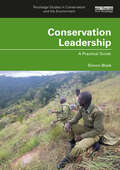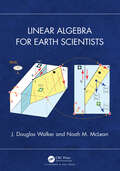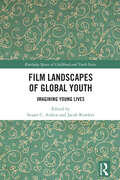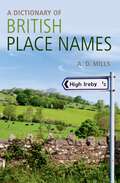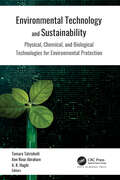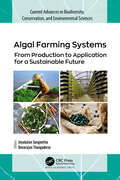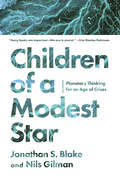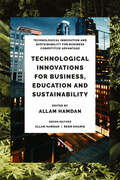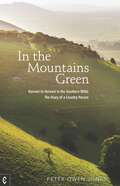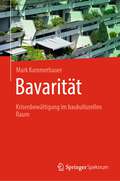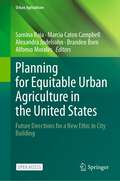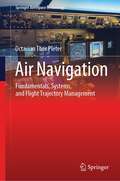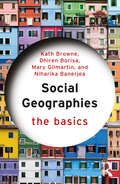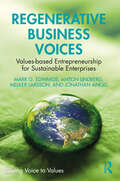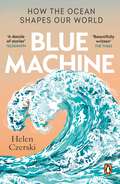- Table View
- List View
Conservation Leadership: A Practical Guide (Routledge Studies in Conservation and the Environment)
by Simon BlackThis book is an important guide for individuals seeking to develop and grow their leadership skills in the wildlife conservation sector, across varied disciplines such as environmental management, conservation biology, and ecotourism.Conservation Leadership addresses what leadership is, why it is important, and how to be an effective leader. It identifies the common pitfalls or mistakes in a leader’s thinking or behaviour, and the unexpected consequences or responses which can arise, and then explores more helpful alternative approaches to leadership. The book is divided into three parts: Part I: Leadership principles Part II: Four areas of profound theory: knowledge, psychology, systems, and variation Part III: Skills and competencies for conservation leaders It focuses on contextual and organisational challenges in conservation, including limited resources, remote locations, fragile species of concern, politics, community conflict, crime, and commercial pressures. The scope is global, using diverse examples such as sea turtle head-starting in South Asia, reforestation in North Africa, bird conservation in North America, human–wildlife interactions in the Himalayas, and post-colonial issues in the Caribbean. Case studies illustrate key learning points from small local teams through to global transnational initiatives. Exercises in each chapter enable the exploration of less-familiar topics, including interpersonal skills, goal setting and performance measurement, plus a unique research-derived conservation leadership self-assessment tool.This book is an essential reading resource for professionals and senior leaders in the wildlife management and conservation sector, as well as students on biodiversity conservation, wildlife conservation, and environmental management courses.
Linear Algebra for Earth Scientists
by J. Douglas Walker Noah M. McLeanLinear Algebra for Earth Scientists is written for undergraduate and graduate students in Earth and Environmental sciences. It is intended to give students enough background in linear algebra to work with systems of equations and data in geology, hydrology, geophysics, or whatever part of the Earth Sciences they engage with.The book does not presuppose any extensive prior knowledge of linear algebra. Instead, the book builds students up from a low base to a working understanding of the sub t that they can apply to their work, using many familiar examples in the geosciences.Features Suitable for students of Earth and Environmental Sciences Minimal prerequisites — written in a way that is accessible and engaging for those without a mathematical background All material presented with examples and applications to the Earth Sciences
Linear Algebra for Earth Scientists
by J. Douglas Walker Noah M. McLeanLinear Algebra for Earth Scientists is written for undergraduate and graduate students in Earth and Environmental sciences. It is intended to give students enough background in linear algebra to work with systems of equations and data in geology, hydrology, geophysics, or whatever part of the Earth Sciences they engage with.The book does not presuppose any extensive prior knowledge of linear algebra. Instead, the book builds students up from a low base to a working understanding of the sub t that they can apply to their work, using many familiar examples in the geosciences.Features Suitable for students of Earth and Environmental Sciences Minimal prerequisites — written in a way that is accessible and engaging for those without a mathematical background All material presented with examples and applications to the Earth Sciences
Film Landscapes of Global Youth: Imagining Young Lives (Routledge Spaces of Childhood and Youth Series)
This book explores the dynamic landscapes of global youth through spatially grounded chapters focused on film and media. It is a collection of incredible works concerning children and young people in, out, and through media as well as an examination of what is possible for the future of research within the intersections of geography, film theory, and children’s studies.It contains contributions from leading academics from anthropology, sociology, philosophy, art, film and media studies, women and gender studies, Indigenous studies, education, and geography, with chapters focused on a spatial area and the representations and relationships of children in that area through film and media. The insights presented also provide a unique and eclectic perspective on the current state of children’s research in relation to the ever-changing media landscape of the 21st century. Film Landscapes of Global Youth approaches the subjects of children and young people in film and media in a way that is not bound by genre, format, medium, or the on-/off-screen binary. Each chapter offers an insightful look at the relationships and portrayals of children and young people in relation to a specific country, culture, or geographic feature.This book is a must-read for anyone interested in the intersections between geography, young lives, and the power of film, television, social media, content creation, and more.
Film Landscapes of Global Youth: Imagining Young Lives (Routledge Spaces of Childhood and Youth Series)
by Stuart C. Aitken Jacob RowlettThis book explores the dynamic landscapes of global youth through spatially grounded chapters focused on film and media. It is a collection of incredible works concerning children and young people in, out, and through media as well as an examination of what is possible for the future of research within the intersections of geography, film theory, and children’s studies.It contains contributions from leading academics from anthropology, sociology, philosophy, art, film and media studies, women and gender studies, Indigenous studies, education, and geography, with chapters focused on a spatial area and the representations and relationships of children in that area through film and media. The insights presented also provide a unique and eclectic perspective on the current state of children’s research in relation to the ever-changing media landscape of the 21st century. Film Landscapes of Global Youth approaches the subjects of children and young people in film and media in a way that is not bound by genre, format, medium, or the on-/off-screen binary. Each chapter offers an insightful look at the relationships and portrayals of children and young people in relation to a specific country, culture, or geographic feature.This book is a must-read for anyone interested in the intersections between geography, young lives, and the power of film, television, social media, content creation, and more.
A Dictionary of British Place-Names (Oxford Quick Reference)
This revised edition of the Dictionary of British Place-Names includes over 17,000 engaging and informative entries, tracing the development of the featured place-names from earliest times to the present day. Included place-names range from the familiar to the obscure, among them 'Beer', 'Findlater', 'Broadbottom', and 'Great Snoring'. The A to Z entries are complemented by a detailed introductory essay discussing the chronology and development of English, Irish, Welsh, and Scottish place-names, as well as an extensive bibliography, maps of Britain showing old and new boundaries, and a glossary of common elements in place-names. Also new to this edition is an appendix of recommended web links pointing to relevant online resources, thereby expanding the scope of the dictionary and providing the reader with an opportunity to explore the subject further. Both accessible and up to date, this dictionary is an ideal companion for anybody travelling around the British Isles, as well as for researchers and students with an interest in toponomy, local history, cartography, and lexicography.
A Dictionary of British Place-Names (Oxford Quick Reference)
by A. D. MillsThis revised edition of the Dictionary of British Place-Names includes over 17,000 engaging and informative entries, tracing the development of the featured place-names from earliest times to the present day. Included place-names range from the familiar to the obscure, among them 'Beer', 'Findlater', 'Broadbottom', and 'Great Snoring'. The A to Z entries are complemented by a detailed introductory essay discussing the chronology and development of English, Irish, Welsh, and Scottish place-names, as well as an extensive bibliography, maps of Britain showing old and new boundaries, and a glossary of common elements in place-names. Also new to this edition is an appendix of recommended web links pointing to relevant online resources, thereby expanding the scope of the dictionary and providing the reader with an opportunity to explore the subject further. Both accessible and up to date, this dictionary is an ideal companion for anybody travelling around the British Isles, as well as for researchers and students with an interest in toponomy, local history, cartography, and lexicography.
Environmental Technology and Sustainability: Physical, Chemical and Biological Technologies for Environmental Protection
by Tamara Tatrishvili Ann Rose Abraham A. K. HaghiThis new title covers the most recent theoretical and practical advancements in green technology for a clean and healthy environment. It aims to provide a better understanding of the research and development of new technologies that are becoming increasingly important for ensuring sustainability.The book provides vital information on advanced materials and green composites and expounds on environmental chemistry for a sustainable world, focusing on different characterization methods as well as new techniques. The volume also considers recent developments and applications of clean energy materials. It presents case studies that emphasize the green technologies being discussed.
Algal Farming Systems: From Production to Application for a Sustainable Future (Current Advances in Biodiversity, Conservation, and Environmental Sciences)
by Jeyabalan Sangeetha Devarajan ThangaduraiThe farming and cultivation of algae can provide sustainable solutions for issues like food security-related problems, costly health-related products, sustainable fuels, and more. However, the use of algae is currently restricted to high-value, low-volume markets, mainly due to the high investment and production costs involved. In recent years, algaculture for food and fuel purposes has begun a transition from R&D and pilot-scale operations to commercial-scale systems. This new book presents the latest technological innovations in algae production, market status, and prospects for algal applications.The book provides an informative overview of different perspectives on the commercial production of algae-based food, health, and high-value cosmeceutical products, providing an institutional framework to support and promote the development and commercialization of algal farming. The book discusses phycotechnology and highlights the current trends and future scope of algal technology. It also presents new information on algal culture conditions and cultivation strategies, including a look at geographic position and local climate as key factors in the implementation of microalgae-based processes. Algal production, marketing strategies, and their commercialization are discussed, as are the industrial applications of algae, focusing mainly on nutraceutical, pharmaceutical, and cosmeceutical applications of microalgae and macroalgae.
Algal Farming Systems: From Production to Application for a Sustainable Future (Current Advances in Biodiversity, Conservation, and Environmental Sciences)
The farming and cultivation of algae can provide sustainable solutions for issues like food security-related problems, costly health-related products, sustainable fuels, and more. However, the use of algae is currently restricted to high-value, low-volume markets, mainly due to the high investment and production costs involved. In recent years, algaculture for food and fuel purposes has begun a transition from R&D and pilot-scale operations to commercial-scale systems. This new book presents the latest technological innovations in algae production, market status, and prospects for algal applications.The book provides an informative overview of different perspectives on the commercial production of algae-based food, health, and high-value cosmeceutical products, providing an institutional framework to support and promote the development and commercialization of algal farming. The book discusses phycotechnology and highlights the current trends and future scope of algal technology. It also presents new information on algal culture conditions and cultivation strategies, including a look at geographic position and local climate as key factors in the implementation of microalgae-based processes. Algal production, marketing strategies, and their commercialization are discussed, as are the industrial applications of algae, focusing mainly on nutraceutical, pharmaceutical, and cosmeceutical applications of microalgae and macroalgae.
Environmental Technology and Sustainability: Physical, Chemical and Biological Technologies for Environmental Protection
This new title covers the most recent theoretical and practical advancements in green technology for a clean and healthy environment. It aims to provide a better understanding of the research and development of new technologies that are becoming increasingly important for ensuring sustainability.The book provides vital information on advanced materials and green composites and expounds on environmental chemistry for a sustainable world, focusing on different characterization methods as well as new techniques. The volume also considers recent developments and applications of clean energy materials. It presents case studies that emphasize the green technologies being discussed.
Children of a Modest Star: Planetary Thinking for an Age of Crises
by Jonathan S. Blake Nils GilmanA clear-eyed and urgent vision for a new system of political governance to manage planetary issues and their local consequences. Deadly viruses, climate-changing carbon molecules, and harmful pollutants cross the globe unimpeded by national borders. While the consequences of these flows range across scales, from the planetary to the local, the authority and resources to manage them are concentrated mainly at one level: the nation-state. This profound mismatch between the scale of planetary challenges and the institutions tasked with governing them is leading to cascading systemic failures. In the groundbreaking Children of a Modest Star, Jonathan S. Blake and Nils Gilman not only challenge dominant ways of thinking about humanity's relationship to the planet and the political forms that presently govern it, but also present a new, innovative framework that corresponds to our inherently planetary condition. Drawing on intellectual history, political philosophy, and the holistic findings of Earth system science, Blake and Gilman argue that it is essential to reimagine our governing institutions in light of the fact that we can only thrive if the multi-species ecosystems we inhabit are also flourishing. Aware of the interlocking challenges we face, it is no longer adequate merely to critique our existing systems or the modernist assumptions that helped create them. Blake and Gilman propose a bold, original architecture for global governance—what they call planetary subsidiarity—designed to enable the enduring habitability of the Earth for humans and non-humans alike. Children of a Modest Star offers a clear-eyed and urgent vision for constructing a system capable of stabilizing a planet in crisis.
Children of a Modest Star: Planetary Thinking for an Age of Crises
by Jonathan S. Blake Nils GilmanA clear-eyed and urgent vision for a new system of political governance to manage planetary issues and their local consequences. Deadly viruses, climate-changing carbon molecules, and harmful pollutants cross the globe unimpeded by national borders. While the consequences of these flows range across scales, from the planetary to the local, the authority and resources to manage them are concentrated mainly at one level: the nation-state. This profound mismatch between the scale of planetary challenges and the institutions tasked with governing them is leading to cascading systemic failures. In the groundbreaking Children of a Modest Star, Jonathan S. Blake and Nils Gilman not only challenge dominant ways of thinking about humanity's relationship to the planet and the political forms that presently govern it, but also present a new, innovative framework that corresponds to our inherently planetary condition. Drawing on intellectual history, political philosophy, and the holistic findings of Earth system science, Blake and Gilman argue that it is essential to reimagine our governing institutions in light of the fact that we can only thrive if the multi-species ecosystems we inhabit are also flourishing. Aware of the interlocking challenges we face, it is no longer adequate merely to critique our existing systems or the modernist assumptions that helped create them. Blake and Gilman propose a bold, original architecture for global governance—what they call planetary subsidiarity—designed to enable the enduring habitability of the Earth for humans and non-humans alike. Children of a Modest Star offers a clear-eyed and urgent vision for constructing a system capable of stabilizing a planet in crisis.
Technological Innovations for Business, Education and Sustainability (Technological Innovation and Sustainability for Business Competitive Advantage)
by Allam Hamdan Reem KhamisAwareness of the essential skills required for thriving in the job market is necessary for educators and employers. Shedding light on the role of industry in promoting work-based learning, Technological Innovations for Business and Education Sustainability considers how technology has both transformed the business landscape, and how it might continue to do so in future. Harnessing the potential of innovative Industry 4.0 technologies such as the Internet of Things (IoT) and Artificial Intelligence (AI) for sustainable business models, contributors rethink core skills required to meet the changing needs of the work environments in terms of modes of education and workplace ethics, as well as the implications of these constantly evolving technologies for employers and workplaces. Chapters analyse in detail how rapidly advancing technologies have already affected recruitment, retail, banking, the oil and gas industry, insurance, financial services, advertising, childhood obesity, human resources and organizational management, small- and medium-sized enterprises (SMEs), cloud computing and more. Fulfilling a growing need for aligning business strategy and educational curriculums with the evolving skills required for business workplaces, Technological Innovations for Business and Education Sustainability presents a thorough understanding of how business, education and technology can enable current and future leaders to contribute positively to the digital transformation currently in play across the globe.
Technological Innovations for Business, Education and Sustainability (Technological Innovation and Sustainability for Business Competitive Advantage)
by Allam Hamdan Reem KhamisAwareness of the essential skills required for thriving in the job market is necessary for educators and employers. Shedding light on the role of industry in promoting work-based learning, Technological Innovations for Business and Education Sustainability considers how technology has both transformed the business landscape, and how it might continue to do so in future. Harnessing the potential of innovative Industry 4.0 technologies such as the Internet of Things (IoT) and Artificial Intelligence (AI) for sustainable business models, contributors rethink core skills required to meet the changing needs of the work environments in terms of modes of education and workplace ethics, as well as the implications of these constantly evolving technologies for employers and workplaces. Chapters analyse in detail how rapidly advancing technologies have already affected recruitment, retail, banking, the oil and gas industry, insurance, financial services, advertising, childhood obesity, human resources and organizational management, small- and medium-sized enterprises (SMEs), cloud computing and more. Fulfilling a growing need for aligning business strategy and educational curriculums with the evolving skills required for business workplaces, Technological Innovations for Business and Education Sustainability presents a thorough understanding of how business, education and technology can enable current and future leaders to contribute positively to the digital transformation currently in play across the globe.
In the Mountains Green: Harvest to Harvest in the Southern Wilds – The Diary of a Country Parson
by Peter Owen Jones'As a boy, I would walk out into the fields alone. Looking south, I set my eyes on the far ridge, wondering, not knowing, what lay beyond it. What world existed there? Now, as a man, I stand on the top of the Downs, up on the mountains green. To the south, the land folds down to the sea, but to the north the boy is there looking back at me…' In a series of joyous, reflective and inspired diary pieces, Peter Owen Jones takes us on a voyage through the yearly cycle – a journey of inner and outer discovery. With the variety and colour of British seasonal life and the beauty of the Sussex countryside as his backdrop, Owen Jones observes the magical in the everyday – in the birds, bees and butterflies, but also in people. With lightness of touch and good humour, he calls for an awakening to the world around us, to ourselves, and ultimately to meaning in life. Originally published as a series of separate articles in Sussex Life magazine, the essays gathered here provide a delightful glimpse into the life of a nature-loving country parson.
Bavarität: Krisenbewältigung im baukulturellen Raum
by Mark KammerbauerDas Buch befasst sich mit der Architektur, dem Städtebau und der Stadtplanung im Freistaat Bayern aus interdisziplinärer, urbanistischer Sicht. Damit verbundene baukulturelle Partizipation kann zur Bewältigung von Krisen beitragen, wenn sowohl Akteure der Planung und Gestaltung als auch der Nutzung berücksichtigt werden. Ziel des Buches ist, den gebauten Raum Bayerns zu lesen und zu verstehen, ihn einer Kritik zu unterziehen, dabei die Erfolge nicht auszublenden, um Lösungen zu präsentieren und um schließlich Raum für die Reflexion und das Imaginieren zu "bauen". Wenn Menschen die gebaute Umwelt lesen und verstehen, dann informiert das auch ihr Handeln, insbesondere, wenn sie partizipativ an Planungs- und Gestaltungsprozessen für die Errichtung des gebauten Raums beteiligt sind. Um diese Phänomene ihrem Kontext entsprechend zu fassen und zu deuten, schlägt das Buch den Begriff der Bavarität vor. Im Fall des Freistaats Bayern und seines ländlich-städtischen Kontinuums als Ergebnis historischer baulich-räumlicher Entwicklung, durch Tradition und Moderne konturiert, stellt Bavarität eine sozio-kulturelle Leistung dar, deren Ergebnis in der Partizipation aller Beteiligten gründet und nicht endet.
Planning for Equitable Urban Agriculture in the United States: Future Directions for a New Ethic in City Building (Urban Agriculture)
by Samina Raja Marcia Caton Campbell Alexandra Judelsohn Branden Born Alfonso MoralesThis open access book, building on the legacy of food systems scholar and advocate, Jerome Kaufman, examines the potential and pitfalls of planning for urban agriculture (UA) in the United States, especially in how questions of ethics and equity are addressed. The book is organized into six sections. Written by a team of scholars and practitioners, the book covers a comprehensive array of topics ranging from theory to practice of planning for equitable urban agriculture. Section 1 makes the case for re-imagining agriculture as central to urban landscapes, and unpacks why, how, and when planning should support UA, and more broadly food systems. Section 2, written by early career and seasoned scholars, provides a theoretical foundation for the book. Section 3, written by teams of scholars and community partners, examines how civic agriculture is unfolding across urban landscapes, led largely by community organizations. Section 4, written by planning practitionersand scholars, documents local government planning tied to urban agriculture, focusing especially on how they address questions of equity. Section 5 explores UA as a locus of pedagogy of equity. Section 6 places the UA movement in the US within a global context, and concludes with ideas and challenges for the future. The book concludes with a call for planning as public nurturance – an approach that can be illustrated through urban agriculture. Planning as public nurturance is a value-explicit process that centers an ethics of care, especially protecting the interests of publics that are marginalized. It builds the capacity of marginalized groups to authentically co-design and participate in planning/policy processes. Such a planning approach requires that progress toward equitable outcomes is consistently evaluated through accountability measures. And, finally, such an approach requires attention to structural and institutional inequities. Addressing these four elements is more likelyto create a condition under which urban agriculture may be used as a lever in the planning and development of more just and equitable cities. This is an open access book.This is an open access book.
Air Navigation: Fundamentals, Systems, and Flight Trajectory Management (Springer Aerospace Technology)
by Octavian Thor PleterThis book takes a new approach to air navigation, extending the classic scope of positioning and guidance to efficient and safe 4D flight trajectory management. Modern air navigation aims at flight trajectories optimisation. There is an infinite number of solutions to the classic navigation problem of flying from one airport to another, but most of them are wasteful of resources and even risky. Minimising all costs and risks incurred by the 4D flight trajectory makes air navigation both efficient and safe, which are key factors in air navigation services. Beyond minimising fuel burn and CO2, efficiency addresses non-CO2 emissions and noise. This is a visually intensive book, using examples and case studies to illustrate the concepts, the physics of navigation and the mathematical models involved. Numerical examples reflect its problem-solving nature. It is useful to aerospace students, engineers, pilots, air traffic controllers, technicians, and scientists curious about aviation.
Gebäudeautomation in Wohn- und Wirtschaftsimmobilien: Energetische Einsparpotenziale durch Gebäudeautomation (Studien zum nachhaltigen Bauen und Wirtschaften)
by Giulio Saric Thomas GlatteMit Gebäudeautomation lassen sich Komfort und Sicherheit eines Gebäudes steigern. Dazu kommt das Potenzial, die Energieeffizienz der Immobilie zu erhöhen, was wirschaftliche Vorteile bei der Bewirtschaftung mit sich bringt. Diese Publikation untersucht verschiedene Smart-Home Technologien im Hinblick auf die Senkung der Energiekosten und vergleicht den ökonomischen Nutzen zwischen Wirtschafts- und Wohnimmobilien. Dabei werden die Anwendungsfelder Beleuchtung, Klimatisierung und Beschattung analysiert und bewertet.
Social Geographies: The Basics (The Basics)
by Kath Browne Dhiren Borisa Mary Gilmartin Niharika BanerjeaSocial Geographies: The Basics introduces what social geography is, and what it might be. It outlines the key contours of social geographies, and also disrupts some of the conventions of the discipline in both its content and structure.This book approaches social geographies by beginning with the resistances, contestations and ‘solutions’ that communities use to challenge exclusions in place and space in order to create equitable societies. It then addresses the inequalities, precarities, and ‘problems’ that prompt these interventions. This allows the book to emphasise the importance of activism in the here and now, and to show how activism often makes issues visible and contested in ways that are then theorised by academics. Social Geographies starts with solidarities, communities, and networks before moving to examine difference, precarity, and mobilities. Each chapter offers key case studies that centre resistance, contestations of inequitable power, and local knowledges that can often be seen as ‘solutions’ to national and transnational issues, creating a decolonial understanding of ‘social geography from below’ within and across national contexts.This book is essential reading for undergraduate students and readers new to the area, as well as anyone studying introductory geography, social, cultural and critical geography, ‘the spatial turn’ and issues of spatialities, and key issues like precarity, power, difference, equality, and mobilities.
Social Geographies: The Basics (The Basics)
by Kath Browne Dhiren Borisa Mary Gilmartin Niharika BanerjeaSocial Geographies: The Basics introduces what social geography is, and what it might be. It outlines the key contours of social geographies, and also disrupts some of the conventions of the discipline in both its content and structure.This book approaches social geographies by beginning with the resistances, contestations and ‘solutions’ that communities use to challenge exclusions in place and space in order to create equitable societies. It then addresses the inequalities, precarities, and ‘problems’ that prompt these interventions. This allows the book to emphasise the importance of activism in the here and now, and to show how activism often makes issues visible and contested in ways that are then theorised by academics. Social Geographies starts with solidarities, communities, and networks before moving to examine difference, precarity, and mobilities. Each chapter offers key case studies that centre resistance, contestations of inequitable power, and local knowledges that can often be seen as ‘solutions’ to national and transnational issues, creating a decolonial understanding of ‘social geography from below’ within and across national contexts.This book is essential reading for undergraduate students and readers new to the area, as well as anyone studying introductory geography, social, cultural and critical geography, ‘the spatial turn’ and issues of spatialities, and key issues like precarity, power, difference, equality, and mobilities.
Regenerative Business Voices: Values-based Entrepreneurship for Sustainable Enterprises (Giving Voice to Values)
by Mark G. Edwards Anton Lindberg Melker Larsson Jonathan AngelThis is a book about the future of sustainability. Regenerative Business Voices: Values-based Entrepreneurship for Sustainable Enterprises tells the stories of four regenerative organizations and the people who have founded them and guided them towards sustaining futures.Regenerative sustainability recognizes the urgency of transforming organizations to reverse the unsustainable pathways we are currently on. Regenerative businesses do not simply do less harm, or produce zero emissions, or optimize the efficient use of natural resources; they also restore and enhance well-being in social and ecological systems. The stories presented here are analyzed using the business ethics approach called Giving Voice to Values (GVV). Through the application of GVV principles, we uncover the processes involved in how regenerative businesses develop and function, and gain insights into how business leaders voice their deep convictions, overcome silencing rationalizations, normalize their execution of personal choice, discover deep purpose in their work, and draw on their personal histories to create new ways of doing business. We present and analyze these cases to understand how and why expressing values can be so crucial in developing sustainable businesses, and to provide practical examples of how individuals can generate enthusiasm, counter objections, gain allies, and prepare for and practice conversations that help them move forward.The book offers managers and sustainability consultants a new way of understanding some of the central dynamics involved in business ethics and organizational change for sustainability. It will be immensely valuable to educators, business students, and practitioners interested in sustainability, environmental business ethics, and corporate social responsibility topics.
Regenerative Business Voices: Values-based Entrepreneurship for Sustainable Enterprises (Giving Voice to Values)
by Mark G. Edwards Anton Lindberg Melker Larsson Jonathan AngelThis is a book about the future of sustainability. Regenerative Business Voices: Values-based Entrepreneurship for Sustainable Enterprises tells the stories of four regenerative organizations and the people who have founded them and guided them towards sustaining futures.Regenerative sustainability recognizes the urgency of transforming organizations to reverse the unsustainable pathways we are currently on. Regenerative businesses do not simply do less harm, or produce zero emissions, or optimize the efficient use of natural resources; they also restore and enhance well-being in social and ecological systems. The stories presented here are analyzed using the business ethics approach called Giving Voice to Values (GVV). Through the application of GVV principles, we uncover the processes involved in how regenerative businesses develop and function, and gain insights into how business leaders voice their deep convictions, overcome silencing rationalizations, normalize their execution of personal choice, discover deep purpose in their work, and draw on their personal histories to create new ways of doing business. We present and analyze these cases to understand how and why expressing values can be so crucial in developing sustainable businesses, and to provide practical examples of how individuals can generate enthusiasm, counter objections, gain allies, and prepare for and practice conversations that help them move forward.The book offers managers and sustainability consultants a new way of understanding some of the central dynamics involved in business ethics and organizational change for sustainability. It will be immensely valuable to educators, business students, and practitioners interested in sustainability, environmental business ethics, and corporate social responsibility topics.
Blue Machine: How the Ocean Shapes Our World
by Helen CzerskiFINANCIAL TIMES 2023 HIGHLIGHT'Helen Czerski weaves together physics and biology, history and science, in a beautifully poetic way.'Professor Alice Roberts'In Helen Czerski's hands, the mechanical becomes magical. An instant classic.'Tristan Gooley, author of How to Read Water'Blue Machine is quite simply one of the best books I have ever read.'Dr George McGavin, zoologist, entomologist and broadcaster'A fascinating dive into the essential engine that drives our world. Czerski brings the oceans alive with compelling stories that masterfully navigate this most complex system.'Gaia Vince, science journalist, broadcaster and author of Nomad Century All of the Earth's ocean, from the equator to the poles, is a single engine powered by sunlight - a blue machine.Earth is home to a huge story that is rarely told - that of our ocean. Not the fish or the dolphins, but the massive ocean engine itself: what it does, why it works, and the many ways it has influenced animals, weather and human history & culture.In a book that will recalibrate our view of this defining feature of our planet, physicist Helen Czerski dives deep to illuminate the murky depths of the ocean engine, examining the messengers, passengers and voyagers that live in it, travel over it, and survive because of it. From the ancient Polynesians who navigated the Pacific by reading the waves to permanent residents of the deep such as the Greenland shark that can live for hundreds of years, she explains the vast currents, invisible ocean walls and underwater waterfalls that all have their place in the ocean's complex, interlinked system.Timely, elegant and passionately argued, Blue Machine presents a fresh perspective on what it means to be a citizen of an ocean planet. The understanding it offers is crucial to our future. Drawing on years of experience at the forefront of marine science, Helen Czerski captures the magnitude and subtlety of Earth's defining feature, showing us the thrilling extent to which we are at the mercy of this great engine.
